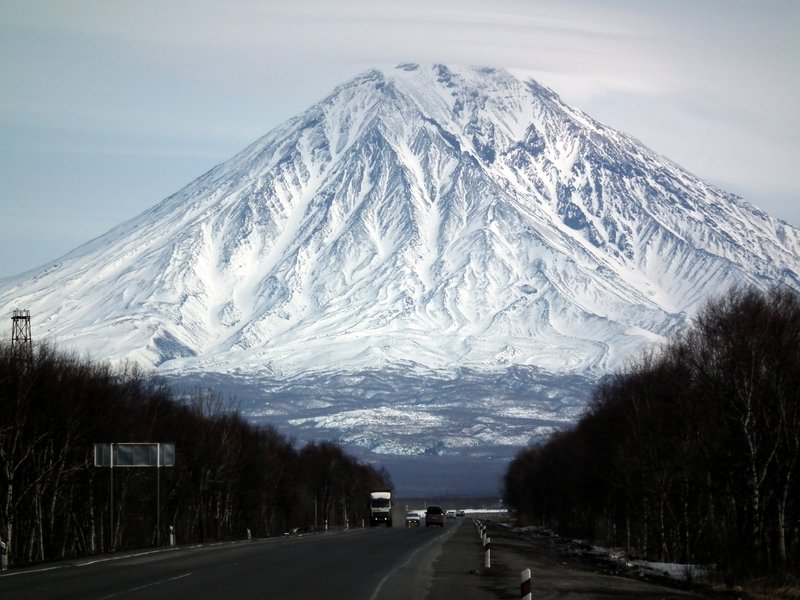Kamchatka
Considered one of the most beautiful places on the planet, the volcano-dotted, bear-infested Kamchatka Peninsula dangles off Russia’s eastern end into the Pacific Ocean eight time zones from Moscow. It’s capital, Petropavlovsk-Kamchatsky, is the second largest isolated city in the world and in fact the entire peninsula has no roads or railways leading to it from the rest of Russia. From the capital one road leads north, petering out halfway up the peninsula and leaving most settlements totally isolated.
Common misconceptions are that travel in Kamchatka is prohibitively expensive and impossible to do independently. A myth has been cultivated that travel here requires the use of helicopters which cost US$2000 an hour. True, they cost that much, but they’re no more necessary than if travelling around France. In either Kamchatka or France, travel by helicopter will add an extra dimension to the trip, get you some stunning views and photos and take you to places that would be difficult to access otherwise. But in neither case are they essential.
The first myth I want to disprove is that getting to Kamchatka is extremely costly. It’s not. Going between February and April, a return flight from Moscow can be had for 11,000 roubles (US$380 / £220). Not bad for 18 hours total flying time. In summer the flights are more expensive but still, if you book them a few months in advance, can be got for 16,000 roubles return.
It’s true, many people will tell you that March and April are the worst months to visit because the snow is starting to melt and everything’s a bit sloshy and dirty in settlements. On the other hand, these are great months for the independent traveller! During winter zimniki (temporary winter roads made of compacted snow or simply frozen river surfaces) open up all over Kamchatka, granting access to communities that in summer are totally isolated. Hitch hiking is possible right from Petropavlovsk-Kamchatsky to the very north of the peninsula. Alternatively, vehicles can be hired in Petropavlovsk-Kamchatsky from tour firms. Also in the winter or early spring months places can be reached that are away even from the zimniki, either by snowmobile or by the use of cross country skis. For example, Klyuchevskaya Sopka, Eurasia’s largest active volcano, can be accessed from the village of Klyuchi without the need even for a guide by a traveller with a pair of cross country skis. Bears do not wake up until mid-April so this is not a danger, but bears almost never attack anyone anyway.
The main disadvantages of winter travel in Kamchatka are that it is cold, there is no greenery and there are no bears, which some people come here especially to see.
The second myth I’d like to dispel is that travel around the peninsula requires hiring a helicopter. As mentioned above, in winter you can get almost anywhere by hitch hiking. I even hitched a lift with bear hunters on snowmobiles from their village to a reindeer herder encampment 100km away. In summer snowmobiles are replaced by horses, and transport is reduced from long distance ice-road journeys to irregular inter-settlement all-terrain vehicle trips. Hitch hiking is possible on these all-terrain vehicles though.
Throughout the year there are fairly expensive public helicopter flights to all settlements which are nevertheless much cheaper than hiring your own helicopter. There is also one permanent, year-round dirt road leading halfway up the peninsula. Some distance after the town of Milkovo, about 350km north of Petropavlovsk-Kamchatsky, it forks. The right fork leads to Klyuchi, site of Eurasia’s largest active volcano, and further to the port town of Ust-Kamchatsk. The left fork leads to the indigenous Even villages of Anavgay and Esso. Daily buses go from Petropavlovsk-Kamchatsky to Klyuchi, Anavgay and Esso, costing about 1000 roubles each way. In winter a zimnik passable by lorries heads north from Anavgay 36 hours to the otherwise isolated town of Palana. From Palana more zimniki head further north to yet more isolated settlements. From the peninsula’s very northernmost settlements there are even EXTREMELY irregular snowmobile and all-terrain vehicle connections with Magadan Oblast and Chukotka. Another zimnik, only passable by all-terrain vehicle, heads from Anavgay to the village of Ust-Khayryuzovo on Kamchatka’s west coast.
As you see, it’s possible to do and see a lot here on the cheap, especially in winter, and with a bit of time and courage you can get to some extremely remote places that have very rarely been visited by travellers before. However, it is of course true that hiring a helicopter will get you better views and photographs of Kamchatka’s stunning natural beauty, as well as getting you out to some places that are almost impossible to access on your own. However, Kamchatka’s people are extremely friendly, and I feel that even without a helicopter you will come away with lots of happy memories and a better understanding of the people and place than if you had spent your entire time in the air!

Leave a Reply